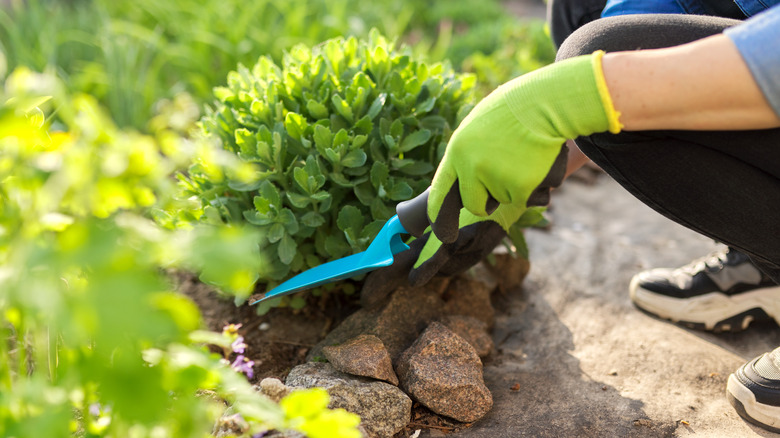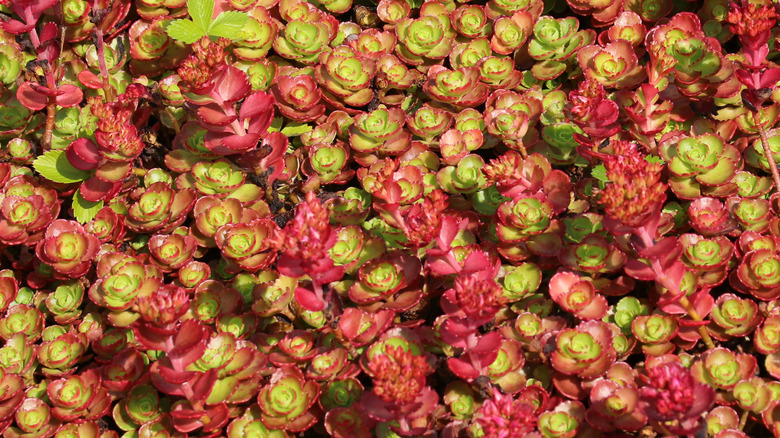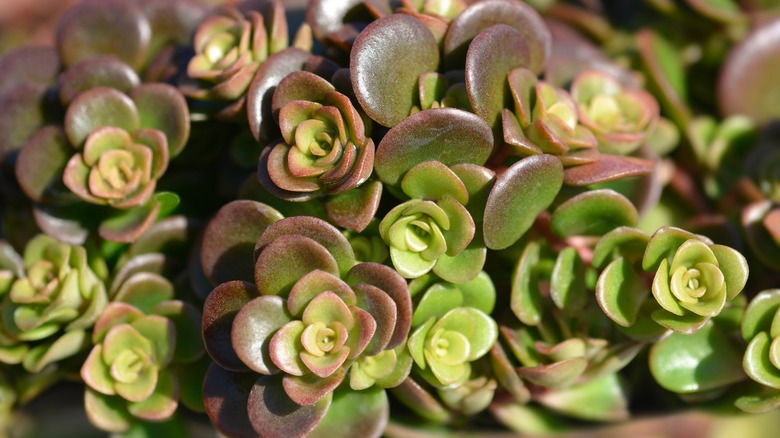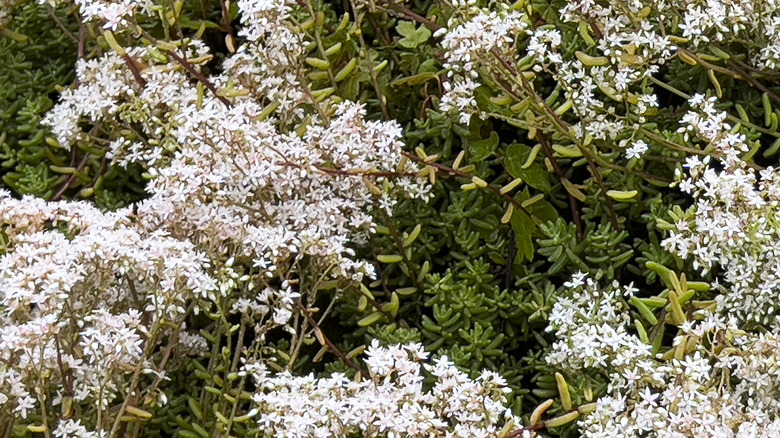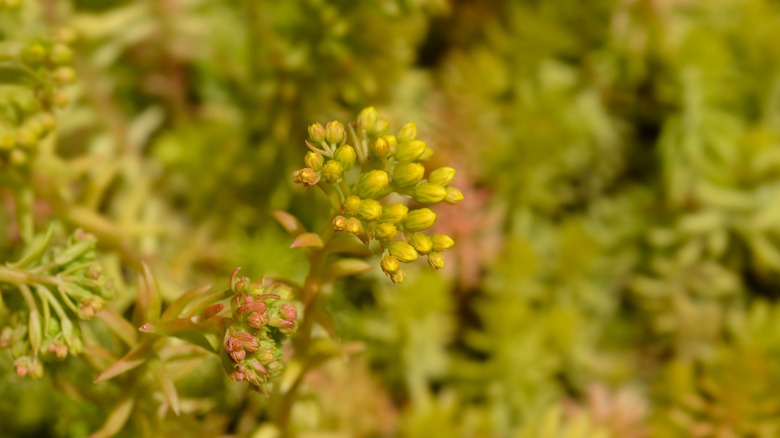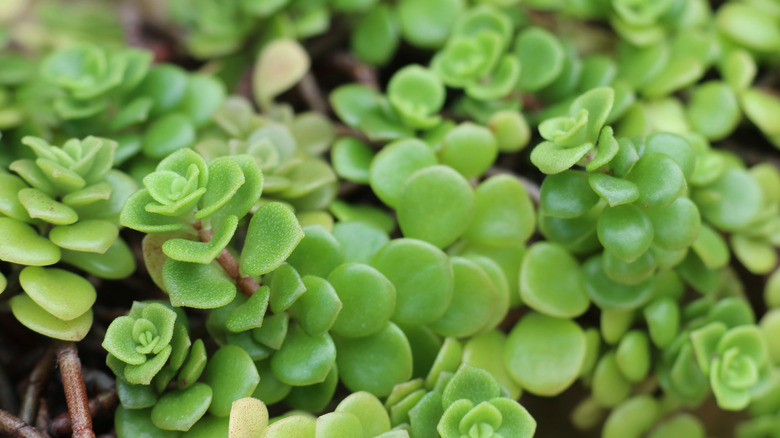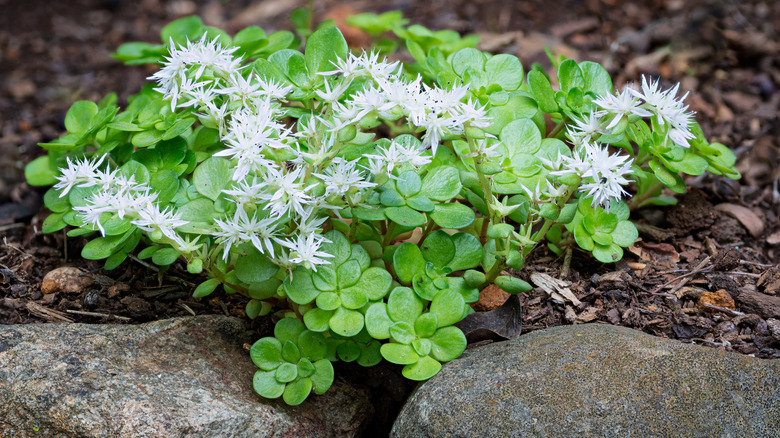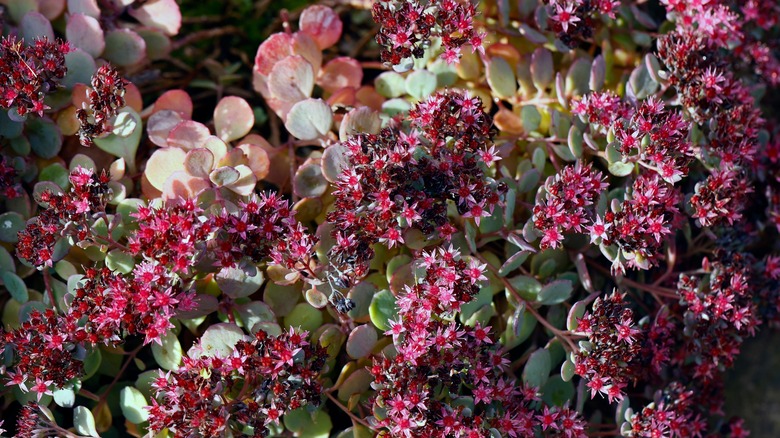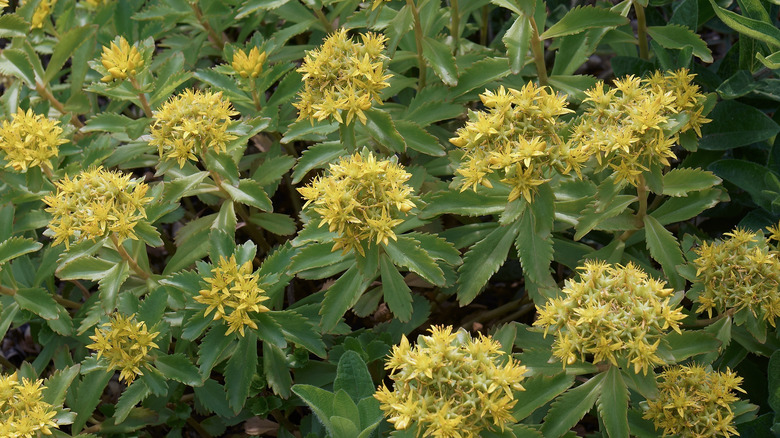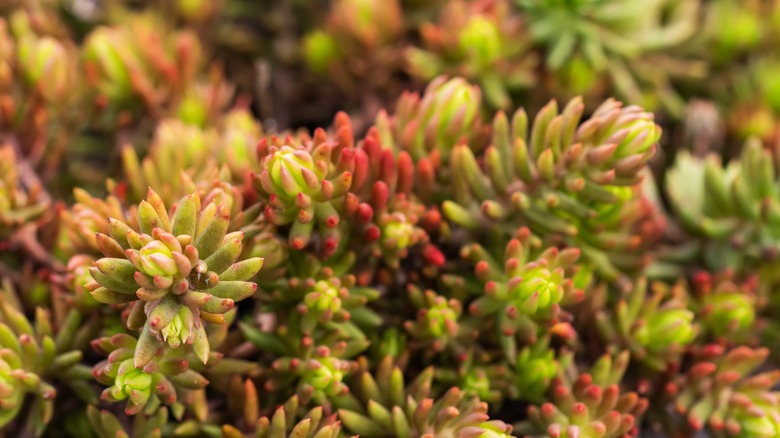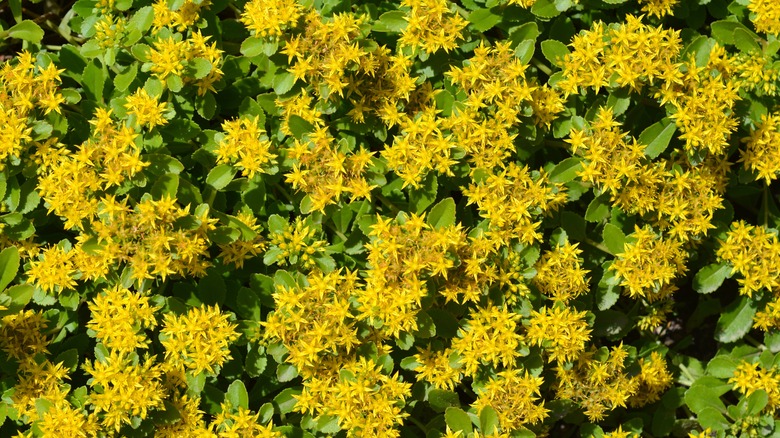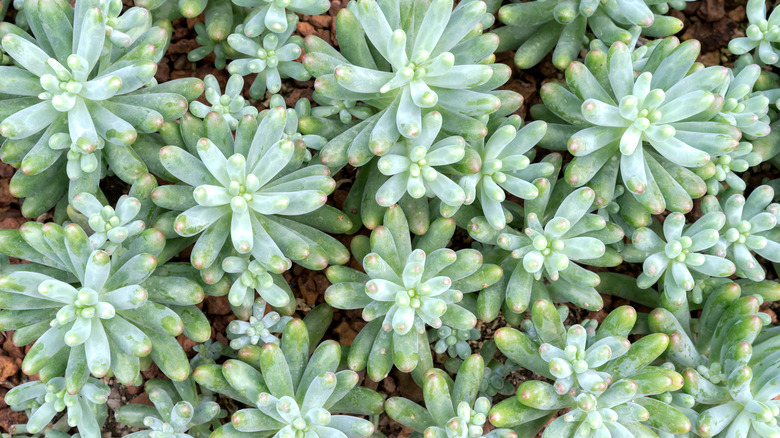11 Sedum Ground Cover Varieties To Add To Your Yard (& How To Care For Them)
Whether you're looking for a ground cover plant to suppress weeds, want to make your flower beds more attractive, or fill the empty spaces beneath trees where your lawn won't grow, there's a sedum species that will work well for you. Sedums can be upright or low-growing, but it's the low-growing type you'll want to focus on for ground cover. These plants can spread or trail along the surface of the ground, often to form dense mats that look like living carpets. With foliage in various shades of green, orange, and red, sedums can add color to the garden throughout the year. They also benefit from pretty flowers that can remain in bloom for weeks on end.
Sedum ground cover plants are sure to be a hit with low-maintenance gardeners because they typically thrive on neglect, needing very little water or attention after planting. Take care to plant your sedum in a spot that receives the kind of light it likes, and then you can mostly leave it to its own devices and simply enjoy the benefits it brings. Many varieties of this ground cover will adapt well to soils that many other plants struggle with, such as shallow, rocky soil, clay soil, and poor, dry soils. Consider using sedum to bring a lush look to areas of the yard where more fussy plants have failed. Here we explore some of the best sedum varieties that are popularly used as ground cover and explain how to get the most out of them.
Plant dragon's blood sedum for striking red foliage in fall
Dragon's blood sedum (Sedum spurium) is a gardener's dream, requiring no attention and thriving in almost any soil type. This trailing succulent is native to Asia, and although, strictly speaking, it is not an evergreen plant, it will hold onto enough foliage throughout the winter months that it has the appearance of being evergreen. Dragon's blood sedum is an excellent ground cover for flower beds or rock gardens, though it won't work as a lawn alternative since it cannot tolerate being trampled on. Use it to bring some low-level color to your yard, with fleshy leaves that remain green through summer and take on a deep maroon shade once fall arrives. Showy star-shaped flowers appear in the warmer months in a pretty pink shade that contrasts nicely against the foliage.
The best place to grow dragon's blood ground cover in your garden is in a sunny site. Though this plant can tolerate light shade, it produces a more intense leaf color when grown in full sun. As a low-maintenance plant that can thrive in a wide range of soil types, including poor soils, you don't need to worry about what kind of planting medium dragon blood sedum is grown in. Like most succulents, this plant is drought-tolerant, but it will appreciate some supplemental watering through hot, dry summers. It is hardy through USDA zones 3 to 8, preferring cool to moderate climates.
Use Chinese sedum as a lawn alternative
Chinese sedum (Sedum tetractinum), as you may have predicted, is native to China. It is a low-growing plant, reaching a maximum of just 3 inches in height, but it can spread as much as 12 inches in width to form a thick, dense mat. The growth habit of Chinese sedum makes it an excellent choice as a lawn alternative, creating a carpet of lush green foliage that is attractive and easy to care for. In its natural habitat, this plant is found growing in damp forests, so it is much better adapted to life in moist soils compared with other sedums, which typically prefer dry soils. Pink or white flowers bloom throughout July and August for additional interest.
Chinese sedum establishes itself quickly, making it an easy and low-maintenance option instead of a traditional lawn. Position plants 12 inches apart to allow them to spread and create a dense carpet. There are some mistakes to avoid when growing sedum as a grass alternative. Although Chinese sedum tolerates shade better than many sedums, it is best not to plant it beneath the shade of trees, because it will perform best in full sun or partial sun. It will thrive in moist or dry soils, but you should avoid watering it like you would a regular lawn, because it cannot tolerate over-watering.
Perennial white sedum produces pretty and petite flowers
White sedum (Sedum album), also known as 'white stonecrop,' is native to Europe and North Africa. It takes its name from the clusters of tiny white flowers it sends out each summer that are held above the foliage on erect stems. This plant is a low-growing evergreen perennial that is commonly used as garden ground cover, spreading through rhizomes via its long and creeping stems. It produces a dense mat of succulent leaves that are green through spring and summer, taking on a red flush at the arrival of fall.
White sedum tolerates a wide range of soil types, including sandy and chalky soils — as long as they are well-draining. The plant is drought tolerant, making it well-suited to dry climates and low-maintenance gardens. It can be used as ground cover between plants in flower beds, between stepping stones, or among a rock garden. It can also work well in containers. Plant it in full sun for the best color.
Crooked yellow stonecrop can tolerate light shade, but prefers full sun
Crooked yellow stonecrop (Sedum rupestre 'Angelina') is native to Europe and also goes by the name 'Angelina stonecrop.' It features yellow-green foliage that forms a dense mat and turns a shade of deep orange in the fall. In its natural habitat, it can be seen growing among sandy soils and along walls, but as a cultivated plant, it is more widely used as a ground cover or in hanging baskets, with trailing stems that cascade beautifully over the edge of containers or rocks. The rapid spreading nature of crooked yellow stonecrop makes it ideal for filling in gaps in containers and flower beds. The heat-tolerant ground cover can also fill in patchy grass spots in your lawn with its lush, fine-textured foliage.
Crooked yellow stonecrop can be grown in light shade, but it prefers full sun. It can adapt to a wide range of soil types, including clay soils and rocky soils, but the plant will avoid acidic soils. It is tolerant of drought, but does not fare well in overly moist soils, so good drainage is crucial to ensure any excess moisture can drain away from its roots. Cooked yellow stonecrop is not popular among deer and rabbits, so it could be planted around shrubs to keep these pesky creatures at bay. This plant would be ideal for gardeners looking for a ground cover to quickly fill their vacant spots, because it grows and spreads rapidly.
Japanese stonecrop produces low-growing leaves that look like rosettes
Japanese stonecrop (Sedum makinoi) makes for a pretty sight in the garden, with tiny, bright green oval leaves that are held in rosette shapes. At a maximum height of 4 inches and a spread of 1 foot, Japanese stonecrop is popularly grown as ground cover. Yellow flowers are produced in summer, along the fleshy stems of this creeping perennial succulent. In its native habitat of Asia, the Japanese stonecrop will be found growing in forests, on sunny sites. The plant can also be cultivated as a houseplant, performing well alongside other succulents and cacti.
This drought-tolerant plant should be situated in full sun or partial sun in the garden. It does not need to be watered, but it can survive in moist soils if they are well draining. The succulent leaves of the Japanese stonecrop have a tendency to break off or fall away, but these can easily be propagated to create new plants. Allow the leaves to sit on top of garden soil where they will readily root and spread.
Woodland stonecrop is ideal ground cover for rocky sites
Woodland stonecrop (Sedum ternatum) is also known as 'wild stonecrop' and 'mountain stonecrop.' It is native to the eastern United States and southeastern Canada, where it grows in moist woodlands, forests, and along riverbanks and mountains. Unlike most types of low-growing sedum, woodland stonecrop is one of the ground cover plants that love shade. This makes it ideal for planting in dark corners of the garden or beneath the shade of trees. The perennial grows to around 6 inches tall and 1 foot wide, spreading along the ground with sprawling succulent stems. The foliage is bright green and fleshy, and white star-shaped flowers arrive in spring.
Woodland stonecrop grows best in shallow, rocky soils, and also tolerates clay soils and poor soils. It makes a wonderful addition to rockeries or gravelly soil where other plants may struggle to thrive. It does well in deep shade or partial shade, but can also tolerate full sun, making it incredibly versatile in terms of where it can be positioned in the garden. Woodland stonecrop doesn't need to be watered, so it represents a good choice for low-maintenance gardens. As an adaptable plant, it will also thrive in moist soils, as long as they drain well. It cannot cope with waterlogged soils, so avoid especially wet sites.
Trailing red carpet stonecrop is a dramatic ground cover
Red carpet stonecrop (Sedum spurium 'Red Carpet') is a colorful cultivar of two-row stonecrop. It has red-flushed foliage throughout spring and summer, which darkens to a deeper red when the weather turns cooler. The showy plant makes for a striking ground cover in a wide range of sites, with its rapidly-spreading stems that form a dense mat of fleshy foliage. The heavy cover provided by this low-growing plant might help control weeds in your garden, as it can choke them out and prevent them from gaining access to light. Small pink flowers arrive in summer and remain for up to four weeks, attracting birds and butterflies to the yard.
Red carpet stonecrop thrives easily in a variety of growing conditions, making it a good choice of ground cover for most gardens. It will perform well in poor soils where other plants cannot grow, spreading across the ground to cover distances of up to 2 feet across. This plant is suitable for growing in USDA hardiness zones 3 to 9, and prefers to be positioned in full sun. Red carpet stonecrop is incredibly drought resistant, but will also tolerate moist soils. It is capable of thriving in almost any soil type, with the exception of wet soils.
Kamchatka sedum is an evergreen ground cover that attracts butterflies
Kamchatka sedum (Sedum kamtschaticum) is an evergreen to semi-evergreen ground cover plant. It produces bright yellow blooms toward the end of summer that emerge from pink buds, and prove to be very popular with butterflies. Add the plant to a wildlife garden or rockery, or fill the gaps around paving stones in the yard. It grows to around 4 inches in height with a spread of up to 1 foot, forming a dense mass of fleshy leaves that are pale green through summer, turning to bronze in fall and winter.
As a very drought-tolerant plant, kamchatka sedum is ideal for dry climates. It should be positioned in full sun and grown in well-draining soil. It performs best in sandy, chalky, or loamy soils, but it can also tolerate poor soils. This plant is suitable for growing in USDA hardiness zones 3 to 8.
Free-rooting coral carpet stonecrop spreads effortlessly to cover the ground
Coral carpet stonecrop (Sedum album 'Coral Carpet') is a cultivar of white stonecrop. It is named after the colorful foliage that is coral when it first emerges, turning to green through summer, and deepening to bronze through winter. The plant spreads easily, sending creeping stems along the ground that root via nodes. Leaves that have broken off from the main plant will also root to form new examples of coral carpet stonecrop. Its ability to continue spreading makes it an ideal candidate for covering areas in larger gardens. Clusters of white butterfly-friendly flowers bloom in summer, held above the fleshy foliage.
Coral carpet stonecrop should be grown in full sun, but it can adapt to light shade. It prefers gravelly and sandy soils, making it a great choice for rock gardens. The dense growth habit of this plant means it can be used to prevent grass from growing in flower beds. It will keep emerging weeds or unwanted grasses in the shade to stunt their growth, resulting in a more attractive, well-kept, and low-maintenance garden.
Orange stonecrop makes a good deer-tolerant ground cover
Orange stonecrop (Sedum floriferum 'Bailey's Gold') is native to Asia, where it spreads along the ground of mountains. As a low-growing sedum, this plant makes an excellent ground cover while adding color and interest to the yard. The leaves emerge in the spring in shades of red before maturing to a bronze-tinged green. Yellow flowers bloom abundantly towards the end of spring and remain on the plant throughout summer. The blooms are held on deep purple stems and will give way to small red fruits later in the year. Orange stonecrop grows up to 6 inches high and 18 inches wide. As a prolific bloomer, it works as a showy addition to the garden while attracting butterflies and keeping deer at bay.
Orange stonecrop is considered to be among the beautiful ground cover plants that deer won't touch in your yard, so plant it around the base of other shrubs and trees to help deter these pesky animals. It is hardy through USDA zones 3 to 8. It enjoys dry conditions, so it's a good addition to rock gardens and low-maintenance yards. Plant it in full sun or partial shade, such as beneath the dappled shade of trees.
Plant fast-growing green ice stonecrop in full sun
Green ice stonecrop (Sedum album 'Green Ice') is known for its fast-growing, olive green foliage. Unlike many other low-growing sedum plants, it retains its green color throughout winter, instead of fading to bronze, making it the perfect ground cover for year-round color in your garden. The flowers of green ice stonecrop are white and star-shaped, appearing in the middle of summer. Growing to a height of 3 inches with a spread of 12 inches, this plant can be used as a ground cover, as a filler in a rock garden, or in a container. It tolerates foot traffic, making it suitable for use as a low-moisture lawn alternative.
Position green ice stonecrop in full sun for best growth. It is a low-maintenance plant that is very drought tolerant, so you won't need to worry about remembering to water it. Once it has been planted, you can leave green ice stonecrop to its own devices because it thrives on neglect. This plant is suitable for growing in USDA hardiness zones 3 to 8.
